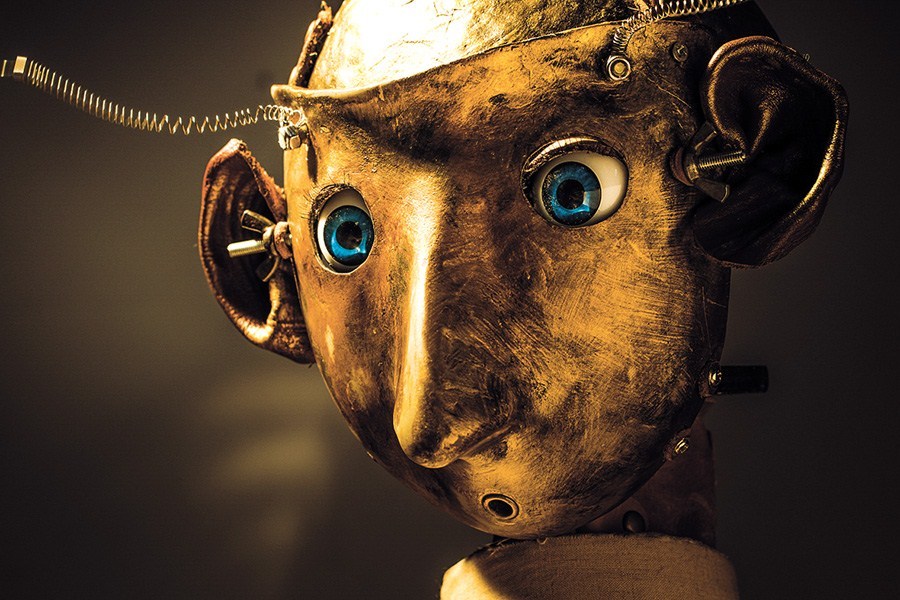Big demand for programs with Chinese elements
2015-11-20
Puppet show “Papa’s Time Machine” — Ding Zhenjie
The month-long 17th China Shanghai International Arts Festival may have ended on Monday, but program purchasers from home and abroad stayed back, busy ironing out details to introduce them at their own festivals and theaters.
About 382 intents have been reached between the artists and organizations, according to the Program Exchange Department of the Center for the Shanghai International Arts Festival. Of these, 168 Chinese shows have been invited to perform abroad, while 143 foreign programs will put up a show elsewhere in China.
It is still early to tally up the number of invitations, as quite a number of intents are usually reached after the Festival with details still to worked out, according to Wang Jun, president of the Center for Shanghai International Arts Festival.
Chinese visual artist Ma Liang’s Puppet Installation Theater “Papa’s Time Machine,” based on Ma’s own childhood life with his father as a Peking Opera director, choreographer Wang Yabin’s Dance Theater “The Moon Opera,” and Yang Liping’s Contemporary Dance “Under Siege,” which was commissioned by the arts festival, were among the most popular shows at the festival’s performing arts fair.
With 14 metal puppets which are the size of a real man and playing traditional Chinese opera elements, “Papa’s Time Machine” attracted more than 20 mainstream overseas buyers, including Southbank Center from the UK, International Festival of Arts and Ideas from the US, Brisbane Festival from Australia, Israel Festival and the Hong Kong Arts Festival.
Yang’s “Under Siege,” featuring historical legends Liu Bang and Xiang Yu, was booked for next year’s Sadler’s Wells in the UK. It also got invites from buyers like John F Kennedy Center for the Performing Arts and OzAsia Festival. Wang’s “The Moon Opera,” which deals with the struggle of a Chinese Peking Opera actress, was also invited to perform at the Sadler’s Wells.
“It seems that contemporary works with strong traditional Chinese elements are almost always the most attractive products in the eyes of overseas buyers,” said Chen Qiang, the director of the Center for Shanghai International Arts Festival’s program exchange department.
“Works of traditional Chinese opera elements are especially popular this year,” said Chen.
“Traditional Chinese opera, a time-honored art form, can be taken as the essence of Chinese performing art. It is natural that it appeals to the Western audiences.”
Though established art forms such as symphonies, ballets and distinctive national dances with good brand names are still the most popular overseas programs in China, they are no longer the highlight at the fair.
With good connections established between domestic buyers and overseas program providers, many deals between the “old fair friends” are now usually reached outside the fair.
“That leaves room for some pioneering programs with advancing technology, which still does not have accesses to the Chinese market,” Chen said.
Digital interactive exhibition “Universe of Sound” by the Philharmonia Orchestra, UK, which allows audiences to walk through, see and hear each elements of the orchestra with the help of immersive film and audio system aroused huge interests among the buyers.
Established in 1999, the festival’s performing arts fair has witnessed rapid growth in 17 years. More than 130 overseas organizations participated in the fair this year — up from 15 in 1999. Major buyers like John F Kennedy Center for Performing Arts, Lincoln Center Festival and Southbank Center have been regular at the fairs, while there are also newcomers every year looking for programs or to explore the Chinese market.
With the new “One Belt One Road” program launched at the festival this year, 22 art festivals from 18 countries joined the group, including the Prague Spring International Music Festival, Budapest Spring Music Festival and Israel Festival.
“Most of these countries enjoy rich culture that are not yet widely recognized by the global audience. Great emerging art markets are also yet to be explored,” said Chen. “As a relatively mature platform this is expected to benefit all sides involved in the project.”
A number of invitations and agreements have been sent and reached among the participants of the Belt and Road, while most Western buyers are still looking on from the sidelines.
“It is understandable for a newly established network. We will keep on perfecting the platform, while expecting more two-way or even multiple-sided exchanges to happen,” Chen said.
(By Zhang Qian Shanghai Daily)
